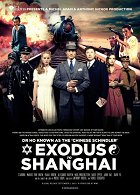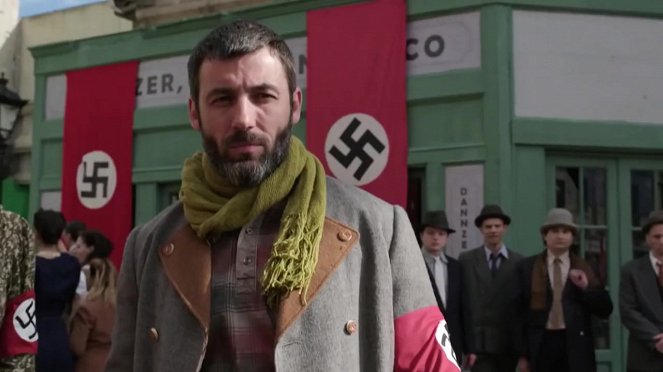Ohjaus:
Anthony HickoxKäsikirjoitus:
Michel AdamKuvaus:
Viorel SergoviciSävellys:
Guy FarleyNäyttelijät:
Markus von Lingen, David Lipper, Maia Morgenstern, Yaara Benben, Alexandre Nguyen, Anthony Hickox, Clem So, Cristian Bota, Srulik Pniel (lisää)Juonikuvaukset(1)
When Hitler invades Austria in 1938, Jews must make an Exodus from Vienna, only the Chinese Consul of Vienna, Dr. Feng Shan Ho issues thousand of Jews an exit visas to Shanghai. Fannia is a beautiful Jewish violin player from New York perfecting her violinist skills in Vienna. She falls in love with Bruce, the son of Dr. Ho, who is a gifted violinist and a martial art profi. Together they are forced into an exodus from Vienna in an exciting adventurous trip to reach Shanghai. On the way the Gestapo tries to stop them from reaching their dreamland and to rob them of their valuables and their lives. (Moscow International Film Festival)
(lisää)Arvostelut (1)
The background of this film’s creation plays a crucial role in fully appreciating it. There actually was a “Chinese Schindler”, Ho Fengshan, who used his position as a consul in Vienna to save thousands of Jews from the Nazis by issuing them Chinese travel visas. However, Michel Adam, who wrote and financed Exodus to Shanghai himself, had a more fundamental influence on this truly unique film project. Adam is bloated Jewish businessman who got rich off the output of textile sweatshops in Thailand and founded the Fashion TV channel in Paris at the turn of the millennium, which made him one of the main drivers of living racks for expensive clothes in later years. When you already have a cocaine-infused brain, a stable of models, warehouses full of clothes, money to burn and a thoroughly bloated ego, the logical next step is to set out into the great wide world of film production. All of this would indicate that Adam’s first creative work would be a sort of Schindler’s List made by a Jewish Zoolander. In relation to Exodus to Shanghai, several instances of emphasising national-ethnic roots are essential, as the film involves pure Jewsploitation that Tarantino’s Inglourious Basterds did not bother with at all. Like the most obscure contributions of the 1970s blaxploitation movement, Adam’s coke-fuelled madness combines within itself overblown appeals to emotion, amateur production facilities, amateur acting, the most basic attractions of every kind, bolstering of his own ethnicity’s self-confidence and martial arts. Michel Adam brings us the story of a Chinese consul who, together with his assistants, servants and a chef, issues thousands of visas for Jews, and his kung-fu assistant, who beats hell out of muscle-bound Nazis and teaches kung-fu to kids with side locks and Jewish beauties (portrayed by Aryan models). In addition to that, there is an excellent parallel storyline about a wealthy old Jewish couple who are art collectors whose collection contains naïve drawings made by a young Adolf Hitler, who is now deploying entire divisions to get them back. Of course, there just has to be scenes in which an old Jew lashes out at fanatical crowds of Nazis and a beautiful young woman kicks a sleazy SS man’s ass, and the climax takes the form of a last stand, when the old couple barricade themselves in their home and mow down groups of Wehrmacht soldiers with machine guns in slow-motion shots. But that is just one of a number of aspects that make Exodus to Shanghai a completely extraordinary phenomenon. The narrative jumps from bombastically impassioned scenes to folk comedy (in the better case in the style of French war farces such as Ace of Aces and La Grande Vadrouille, and in the worse case in the spirit of Zdeněk Troška) to a kitschy romance and a hysterical Holocaust flick. In Adam’s eyes, this is supposed to be a seriously intended tribute to his mother, who evidently fell in love with a Chinese consulate employee in the 1930s. Irrationality, pomposity and stimulant-laced artistic license comprise the alpha and the omega here, so it should not be surprising that no one put a lot of thought into any sort of historical accuracy, causality, logic or stylistic restraint. On the contrary, every scene is characterised by unfocused impulsiveness and deliberate excessiveness. It thus comes as no surprise that, for example, the main villain’s office seems to have been designed with the goal of cramming as many swastikas as possible into a single room or that the guards are standing on the windowsills in the shots in front of the consulate. There is also a simple explanation for why prostitutes in a Nazi brothel are dressed like models from the 21st century – because Adam's company has warehouses full of such clothes. A number of scenes do not refute the hiring of all manner of acquaintances, so in the crowd scenes the camera oddly glides past the extras so that everyone can enjoy their fifteen frames of fame. The main poster tableau is reserved for the leading models, which corresponds to their acting performances. The major roles are occupied by veteran actors whose filmographies include titles such as Skyfall and Star Wars, but a closer look reveals that they portrayed characters such as the fourth soldier on the right. Even this does not conclude the list of bizarre and phantasmagorical aspects of this epic, and that’s not to mention the bizarre context that the same story is now being turned into a television series in a Czech-Chinese co-production project. A separate chapter comprises the experience of the film’s screening in the Berlin film market, which involved the properly unsensible premiere with the participation of all of the main actors, creators and models, as well as a delegation from the Chinese embassy. Exodus to Shanghai is simply a truly unforgettable experience and an unprecedented film project.
()
(vähemmän)
(lisää)

